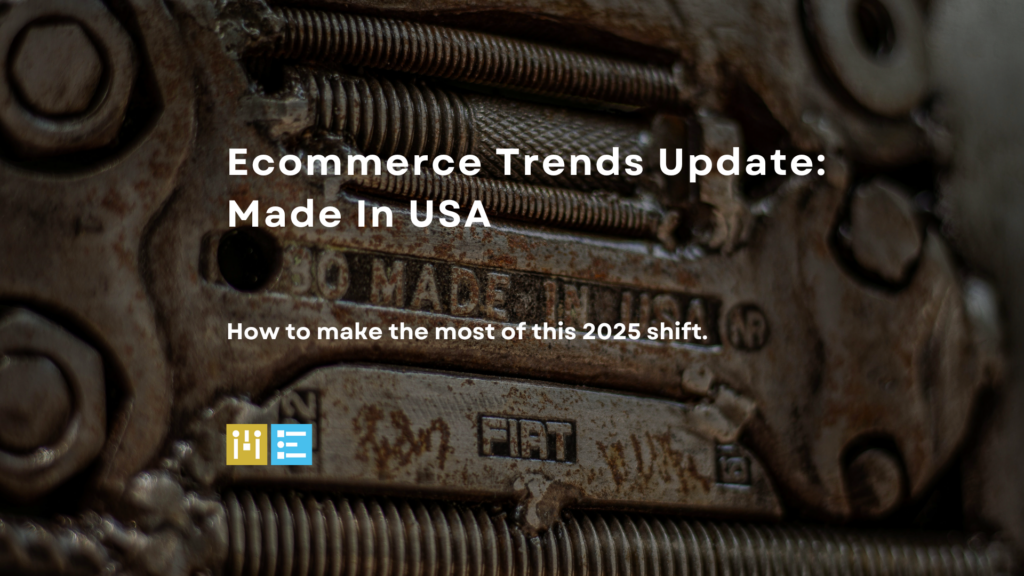
Ride the Wave: Why the “Made in America” Trend is Crucial for Your E-commerce Business (And How to Capitalize)
You’ve likely noticed it in headlines and conversations: tariffs, trade tensions, and supply chain woes are bringing renewed focus to domestic manufacturing. Alongside this, there’s a palpable surge in consumer interest for products proudly bearing the “Made in the USA” label. As an e-commerce business owner, this isn’t just background noise – it’s a significant market trend you need to pay attention to.
Recent data confirms this isn’t just anecdotal. Studies show a strong and persistent preference among American consumers for U.S.-made goods. For instance, a February 2025 Ipsos iSay poll found that 61% of American shoppers consider whether a product is American-made when making a purchase. Even more compelling, a Reshoring Institute survey found nearly 70% prefer American-made products, and a staggering 83% would pay up to 20% more for them.
So, why is this happening now, and why should your e-commerce business care?
Why “Made in America” Matters (More Than Ever) for E-commerce
Economic Factors & Tariffs: Discussions and implementations of tariffs inherently increase the cost and complexity associated with imported goods. This can make domestically produced items relatively more competitive on price, or at least reduce the price gap. Consumers, wary of potential price hikes on imports, may actively seek domestic alternatives (one study found 30% consider this). While tariffs can create broad market uncertainty, they explicitly drive interest towards domestic options.
Consumer Values & Trust: Buying “Made in USA” aligns with many consumers’ values. They often associate it with:
- Supporting the Local Economy & Jobs: A large majority (81%) prefer buying American to keep money local (Ipsos iSay).
- Higher Quality Perception: Many consumers (around 64% in 2025, though slightly down from previous years) believe U.S.-made goods are of higher quality and durability (Ipsos iSay, Reshoring Institute).
- Ethical & Environmental Considerations: Shorter supply chains are perceived as potentially better for the environment (54% believe this – Ipsos iSay), and consumers may trust U.S. labor standards more.
- National Pride & Identity: For some segments, particularly Republicans (75% prioritize), buying American is an expression of patriotism (Ipsos iSay).
- Supply Chain Reliability: Recent global disruptions have highlighted the fragility of long, complex supply chains. Sourcing domestically can offer greater stability, faster turnaround times, and potentially easier logistics – benefits that resonate with consumers seeking reliability.
- Brand Differentiation & Pricing Power: Highlighting domestic production can be a powerful differentiator in a crowded online marketplace. It allows you to build a brand story around quality, community support, and reliability. As mentioned, this perceived value often allows businesses to command a higher price point.
Optimizing Your Website to Showcase “Made in America”
If you offer U.S.-made products, make it easy for interested customers to find them. Here’s how:
Clear Labeling & Identification:
- Product Pages: Clearly state “Made in USA” near the product title, in the description, and specifications. Use official-looking icons or badges if appropriate (but ensure compliance!).
- Navigation & Filtering: Add a “Made in USA” category or collection. Implement filters allowing users to sort or view only domestically produced items.
- Site-Wide Signals: Consider adding a “Made in USA” mention or icon in your website footer or header if a significant portion of your products qualify.
Dedicated Content:
- Landing Pages: Create a specific landing page showcasing all your American-made products, explaining the benefits and your commitment.
- “About Us” Story: Weave your commitment to U.S. manufacturing into your brand story. Highlight local sourcing, the workforce, or the history of your domestic production.
- Blog Posts: Write articles detailing the benefits of buying American-made in your specific product category (quality, materials, craftsmanship).
SEO Optimization:
- Keywords: Incorporate terms like “Made in USA,” “American Made,” “[Your Product] made in America,” etc., naturally into product titles, descriptions, category pages, and blog content.
- Image Alt Text: Describe images using relevant keywords, e.g., “Handcrafted leather wallet made in USA.”
- Structured Data (Schema): Use Schema.org markup on your product pages to explicitly state the country of origin for search engines.
Advertising Your American-Made Advantage
Don’t just optimize your site; actively promote your domestic advantage:
- Targeted Ad Campaigns: Use platforms like Google Ads and social media advertising to target users searching for “Made in USA” products or expressing interest in related topics (e.g., local business support, sustainability).
- Compelling Ad Copy: Highlight the “Made in USA” aspect directly in your ad headlines and descriptions. Emphasize key benefits like quality, supporting American jobs, faster shipping, or unique craftsmanship.
- Visual Storytelling: Use images and videos in your ads that showcase the American manufacturing process, your facility, or your U.S.-based team. Evoke quality and authenticity.
- Leverage Directories & Partnerships: List your business on directories specifically focused on American-made goods (like those mentioned by Foremost Media: AmericanManufacturing.org, AmericansWorking.com). Consider partnerships with complementary U.S.-based brands for cross-promotion.
- Address the Value Proposition: If your products are priced higher than imports, use your advertising to justify the cost by focusing on superior quality, durability, ethical production, and the long-term value offered.
The Takeaway
The growing interest in “Made in America” products, amplified by global trade dynamics, presents a significant opportunity for e-commerce businesses. By strategically optimizing your website and tailoring your advertising to highlight your domestic production, you can tap into strong consumer preferences, build brand loyalty, potentially justify premium pricing, and differentiate yourself in the marketplace. Don’t let this wave pass you by – showcase your American-made pride!

